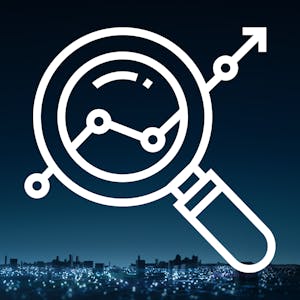Description
This program will teach you fundamental data skills that can be applied across functions and industries. You'll learn how to use Excel to analyse data and build models, SQL to query databases, and Tableau to create informative data visualisations.
Syllabus:
Course 1: Welcome to the Program
Project: Interpret a Data Visualization
You will get to know your instructors and learn how data is used in a variety of industries during the lessons leading up to your first project.
You will also learn about the course structure, navigation, learning resources, deadlines, projects, and everything else that will assist you in succeeding in this course. Then you'll start working on your first project, in which you'll use interactive dashboards to gain insights. Working with data entails being able to interpret data visualisations and explain your findings to others. This project will help you develop your intuition for working with data dashboards while also demonstrating the types of beautiful visualisations you will be able to create by the end of the program!
Course 2: Introduction to Data
Descriptive Statistics I
- Learn data types, measures of center, and the basics of mathematical notation.
Descriptive Statistics II
- Learn a common visual method for quantitative data, measures of spread, and the difference between descriptive and inferential statistics.
Spreadsheets: Getting Started
- Learn about the keys steps of the data analysis process.
- Use cell referencing and menu shortcuts.
Spreadsheets: Manipulate Data
- Sort and filter data.
- Use text and math functions
- Split columns and remove duplicates.
Spreadsheets: Analyze Data
- Summarize data with aggregation and conditional functions.
- Use pivot tables and lookup functions.a
Spreadsheets: Visualize Data
- Build data visualizations for quantitative and categorical data.
- Create pie, bar, line, scatter, histogram, and boxplot charts.
- Build professional presentations.
Metrics
- Become familiar with business metrics used by business analysts in the area of marketing, sales, growth, engagement, and financial analysis.
- Calculate and interpret key performance metrics
- Calculate metrics and create plots to visualize metrics in Excel.
Excel Modelling
- Understand the fundamentals of sales and financial forecasting models.
- Create forecasting models using advanced lookup and data validation tools (INDEX, MATCH, OFFSET)in Excel.
Project: Analyze NYSE Data
You will be working with a New York Stock Exchange (NYSE) dataset that contains fundamental financial data for 500 companies in this project. Using statistics and data visualisations, you will analyse and summarise the data using spreadsheets. You will present the main findings in a professional manner. You will also create a dashboard in Excel that calculates financial metrics and auto populates the income statement for each company based on data validation and advanced lookup tools. Then, within the Income Statement, you will forecast financial metrics based on three scenarios with distinct assumptions for a company of your choice from the NYSE dataset.
You will be able to:
- Calculate summary statistics using spreadsheets by the end of this project.
- Use spreadsheets to create data visualisations.
- Pose questions and provide data-driven answers.
- Work with real-world data that contains gaps and errors.
- Calculate and interpret key business metrics in financial analysis.
- Using scenario analysis, forecast financial metrics.
Course 3: SQL for Data Analysis
Basic SQL
- Become fluent in basic SQL commands including SELECT, FROM, WHERE, and corresponding logical operators.
SQL Joins
- Combine data tables using SQL joins to to answer more complex business questions.
SQL Aggregations
- Aggregate data in SQL including COUNT, SUM, MIN, and MAX.
- Write CASE and DATE functions, as well as work with NULL values.
Advanced SQL Lessons [Optional]
- Use subqueries, also called CTEs, in a number of different situations.
- Use window functions including RANK, NTILE, LAG, LEAD new functions along with partitions to complete complex tasks.
- Clean data, optimize queries, and write advanced JOINs.
Project: Query Digital Music Store Database
You will be able to:
- Write SQL to query a single table by the end of this project.
- Create SQL queries to query multiple tables.
- Pose a question that necessitates data from multiple sources, then join the data and answer the question.
- Set up SQL on your own machine, upload a database, ask complex questions about the data in a database, and query the database to get answers.
Course 4: Data Visualization with Tableau
Data Visualization Fundamentals
- Evaluate the quality of data visualizations and build high quality visualizations.
Design Principles
- Implement the best design practices, and to use the most appropriate chart for a particular situation.
Creating Visualizations in Tableau
- Build data visualizations in Tableau.
- Use data hierarchies, filters, groups, sets, and calculated fields.
- Create map-based data visualizations in Tableau.
Telling Stories with Tableau
- Build interactive Tableau dashboards.
- Tell impactful stories using data.
Project: Build Data Dashboards
By the end of this project, you should be able to:
- Choose the best data visualisation for an analysis.
- Assess the usefulness of a data visualisation.
- Create engaging and interactive Tableau dashboards.









